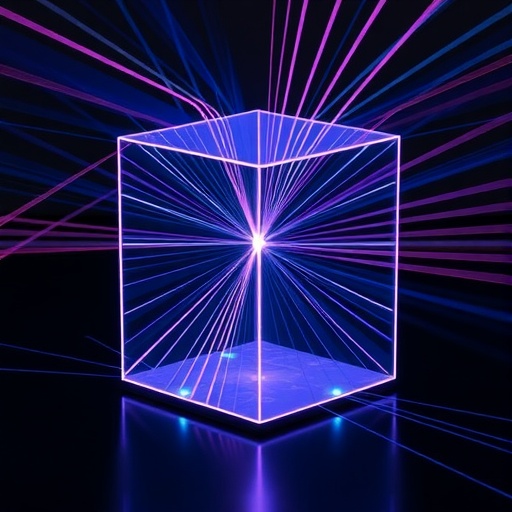
In a groundbreaking advance that bridges the realms of optics and quantum physics, a team led by Professor Qiwen Zhan has unveiled a novel photonic quantum emulator based on the generation of spatiotemporally structured light exhibiting spherical symmetry. Detailed in their recent publication in eLight, this research pioneers a new class of light fields that emulate the potential-free Schrödinger equation, opening unprecedented pathways to explore quantum phenomena through purely optical means. Their approach leverages sophisticated inverse conformal mapping techniques combined with spatiotemporal holography, culminating in the precise control and sculpting of light wavepackets characterized by two quantum numbers.
The foundational principle behind this work derives from a decades-old conjecture by Richard Feynman, who proposed that complex quantum systems could be effectively simulated by more accessible, classical or semiclassical analogs. Such quantum emulators have since found countless implementations across various physical platforms, including trapped ions, ultracold atoms, and nuclear magnetic resonance. This study situates itself uniquely within photonics by exploiting the deep mathematical analogy between the paraxial equation governing optical beam propagation and the Schrödinger equation fundamental to quantum mechanics. Consequently, structured light fields can be engineered to mirror quantum wavefunctions, thereby serving as an optical sandbox for quantum dynamics.
Central to the research is the generation of spatiotemporal light fields exhibiting full spherical symmetry. Unlike conventional beams that typically exhibit cylindrical or planar symmetry, these wavepackets possess rotational invariance in three-dimensional space and time, akin to spherically symmetric quantum states. Such symmetry is critical because it corresponds directly to solutions of the free-particle Schrödinger equation without the constraints of potential energy landscapes. These spherically symmetric light pulses intrinsically embody localized, propagation-invariant wavepackets, a feature highly desirable for studying coherent quantum-like phenomena.
.adsslot_C2DLG1TKAQ{width:728px !important;height:90px !important;}
@media(max-width:1199px){ .adsslot_C2DLG1TKAQ{width:468px !important;height:60px !important;}
}
@media(max-width:767px){ .adsslot_C2DLG1TKAQ{width:320px !important;height:50px !important;}
}
ADVERTISEMENT
To accomplish this, the researchers developed a sophisticated holographic toolbox that combines inverse conformal mapping—transforming circular domains into linear ones—with advanced spatial and temporal modulation capabilities. This technique enables the precise back-propagation design of the optical field Ψ(l,m), which after transformation yields localized spherical harmonic wavepackets denoted as ψ(l,m), characterized by controllable quantum numbers (l, m). The ability to manipulate and generate wavefunctions analogous to these quantum numbers in an optical system represents a significant leap in photonic quantum simulation.
Detailed measurements and visualizations illustrate the complex intensity and phase distributions of the generated wavepackets. Three-dimensional iso-intensity surface plots reveal multiple ring-like lobes, separated by precise phase distributions consistent with spherical harmonics at a temporal snapshot (τ = 0). The peaks of these structures are meticulously controlled, maintaining iso-surfaces at approximately 1% of the maximum intensity, ensuring both spatial localization and temporal stability. These experimental confirmations of the theoretical model underscore the robustness of the approach.
The implications of this research transcend fundamental optics and quantum physics. By providing a flexible platform to emulate quantum states and their evolutions, these spherical harmonic wavepackets could redefine experimental quantum simulation paradigms. The free-space nature of these photonic wavefunctions eliminates complications arising from potential fields, enabling clearer investigations into phenomena like quantum interference, decoherence, and entanglement in controlled photonic settings.
Furthermore, these spatiotemporal localized wavepackets hold promise for advancing light-matter interaction studies. Their propagation-invariant properties and controlled symmetry facilitate enhanced coupling with atomic, molecular, and solid-state quantum emitters, potentially promoting new regimes of strong-coupling quantum optics. This could accelerate developments in quantum information processing, precision metrology, and coherent control of quantum states using purely optical tools.
The inverse conformal mapping approach applied here represents a powerful conceptual tool in photonics. By transforming complex spatial domains into more manageable geometries, it allows for the precise design and realization of complex wave functions in practical optical systems. Combined with programmable spatiotemporal holography, this method offers unparalleled versatility in generating arbitrary spatiotemporal wavepackets, including those emulating more exotic quantum states beyond spherical harmonics.
This research also highlights the broader importance of embracing spatiotemporal structuring in light fields. Traditional photonics has often focused on spatial beam shaping alone; however, incorporating time-domain control unlocks richer degrees of freedom. The resulting fields not only exhibit intricate spatial variations but also temporal dynamics that map elegantly onto quantum state evolution, providing a dynamic playground for exploring transient quantum effects in optics.
As Professor Zhan and colleagues anticipate, these localized wavepackets could catalyze novel applications, ranging from advanced quantum simulators constructed entirely with light to enhanced spectroscopy techniques sensitive to subtle quantum coherences. They may also contribute to developing optical analogs of quantum motors, topological quantum states, and other phenomena conventionally restricted to condensed matter or cold atom systems.
This pioneering photonic quantum emulator stands as a testament to the power of marrying mathematical physics with cutting-edge optical engineering. It demonstrates that light, shaped in both space and time with exquisite precision, can serve not just as an information carrier but as an active participant in simulating quantum reality. As such, it paves the way for experiments probing the quantum-classical boundary via purely classical waves, expanding our toolkit for both fundamental studies and applied quantum technologies.
In summary, the successful generation of spherically symmetric spatiotemporal wavepackets presented here ushers in a new era where structured light can emulate quantum free-particle dynamics without imposing external potentials. This breakthrough promises to deepen our understanding of quantum mechanics and propel forward the capabilities of quantum simulators in photonics, marking a milestone in the ongoing quest to harness light for quantum science.
Subject of Research: Photonic Quantum Emulators and Spatiotemporally Structured Light
Article Title: Spatiotemporal photonic emulator of potential-free Schrödinger equation
Web References:
DOI: 10.1186/s43593-025-00096-8
Image Credits: Cao, Q., Zhang, N., Chong, A. et al.
Tags: engineered light wavepacketsinverse conformal mapping techniquesoptical beam propagation and quantum mechanicsoptical quantum emulationphotonics and quantum physics intersectionpotential-free Schrödinger equationquantum dynamics optical sandboxquantum phenomena explorationRichard Feynman quantum conjecturespatiotemporal holography applicationsspatiotemporal photonic emulatorstructured light fields





